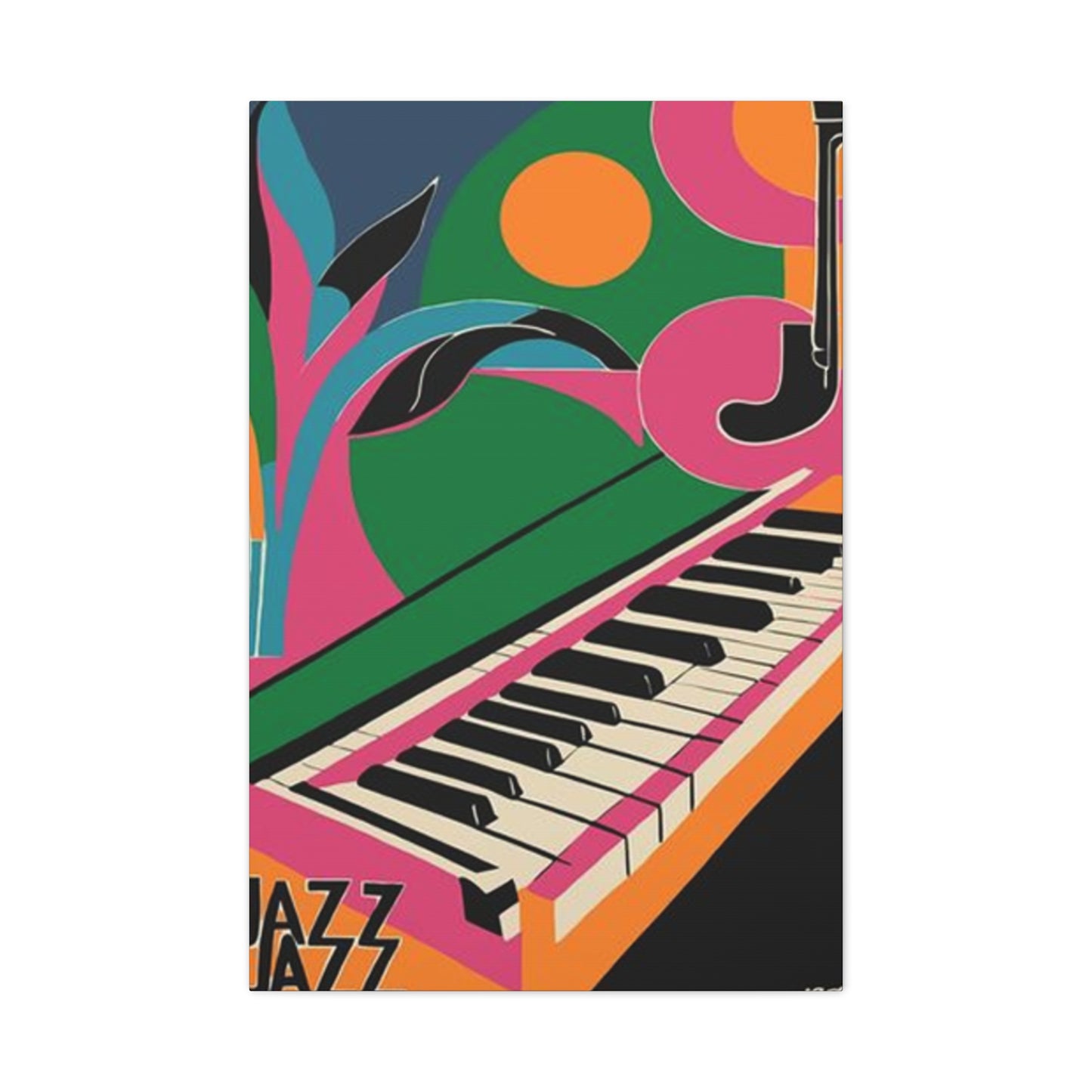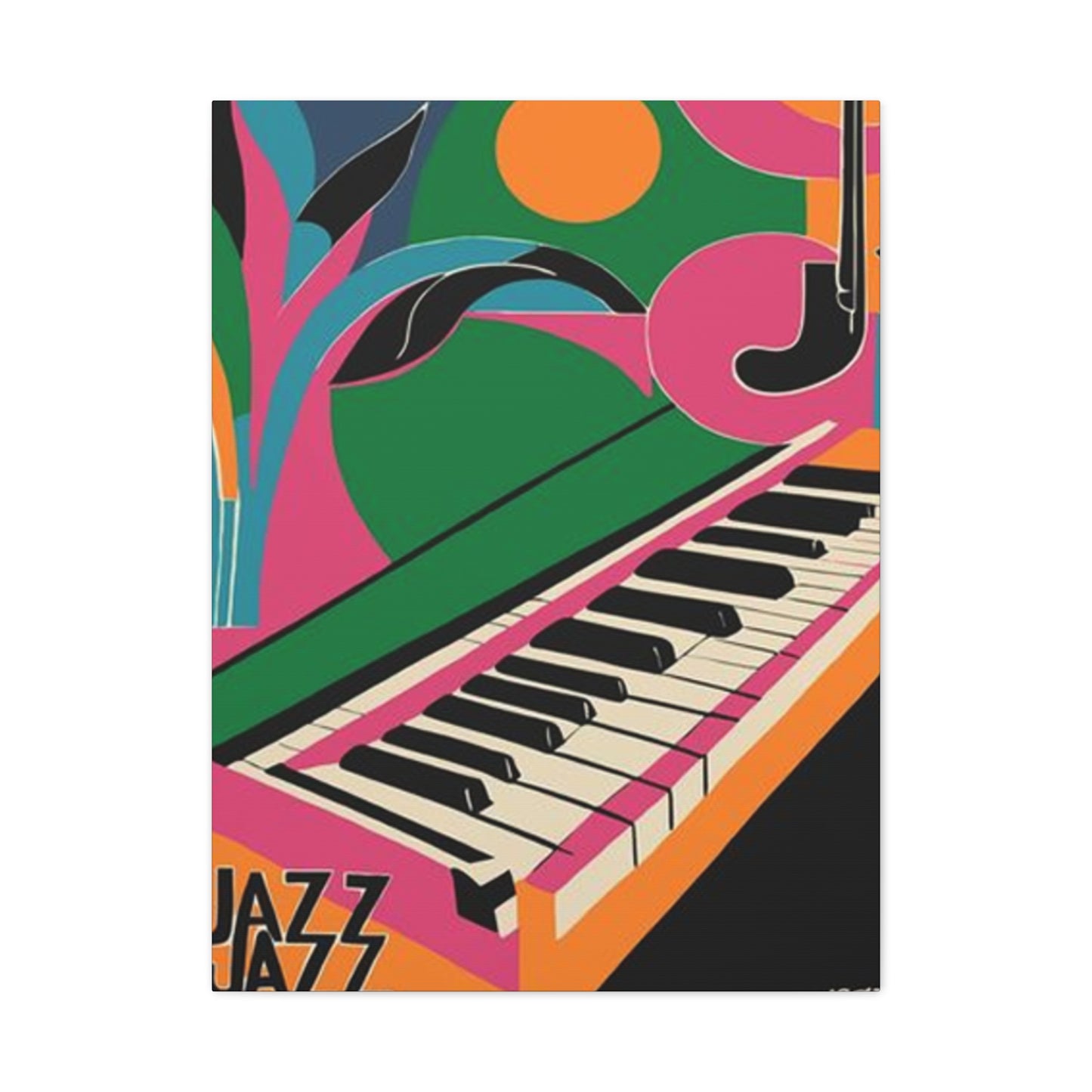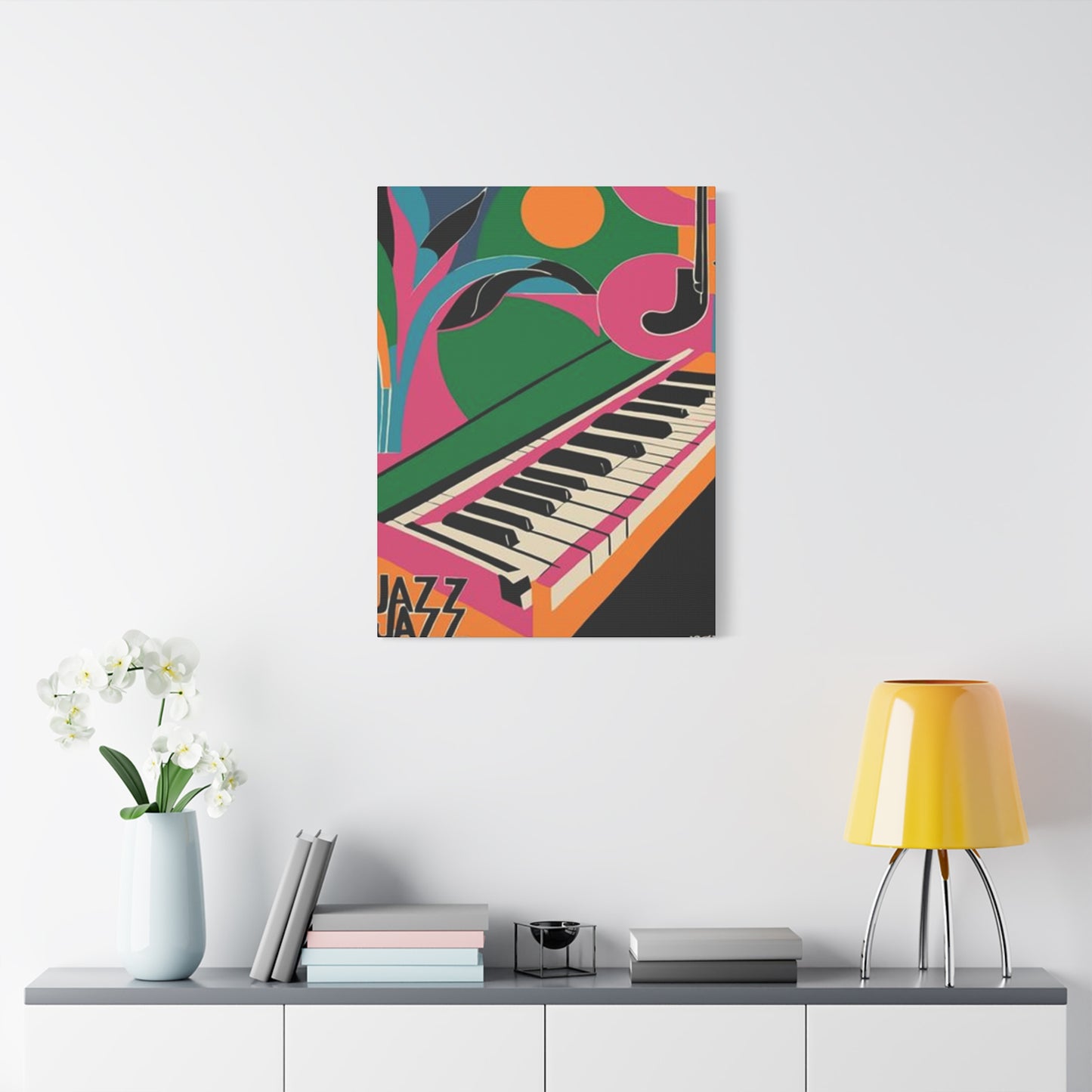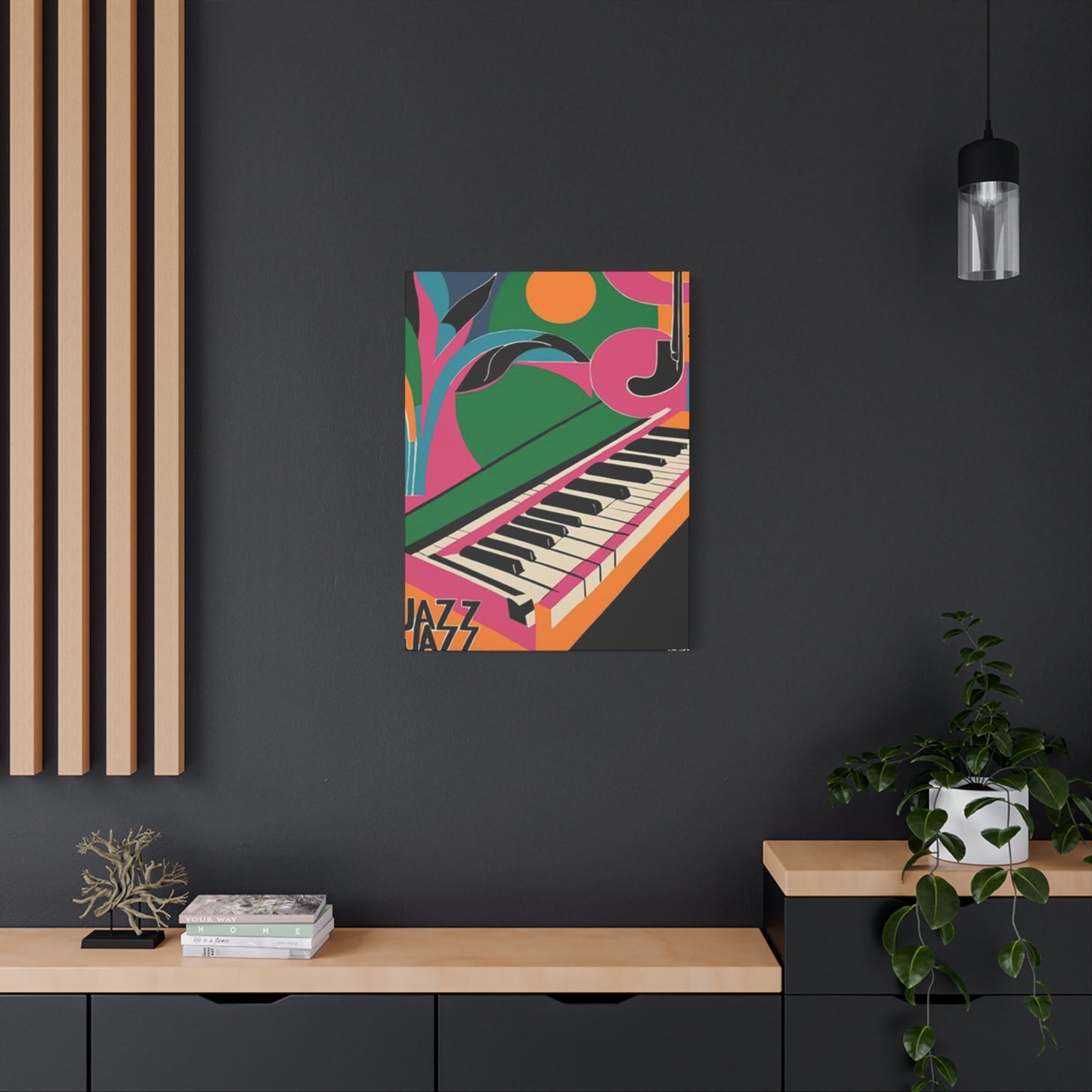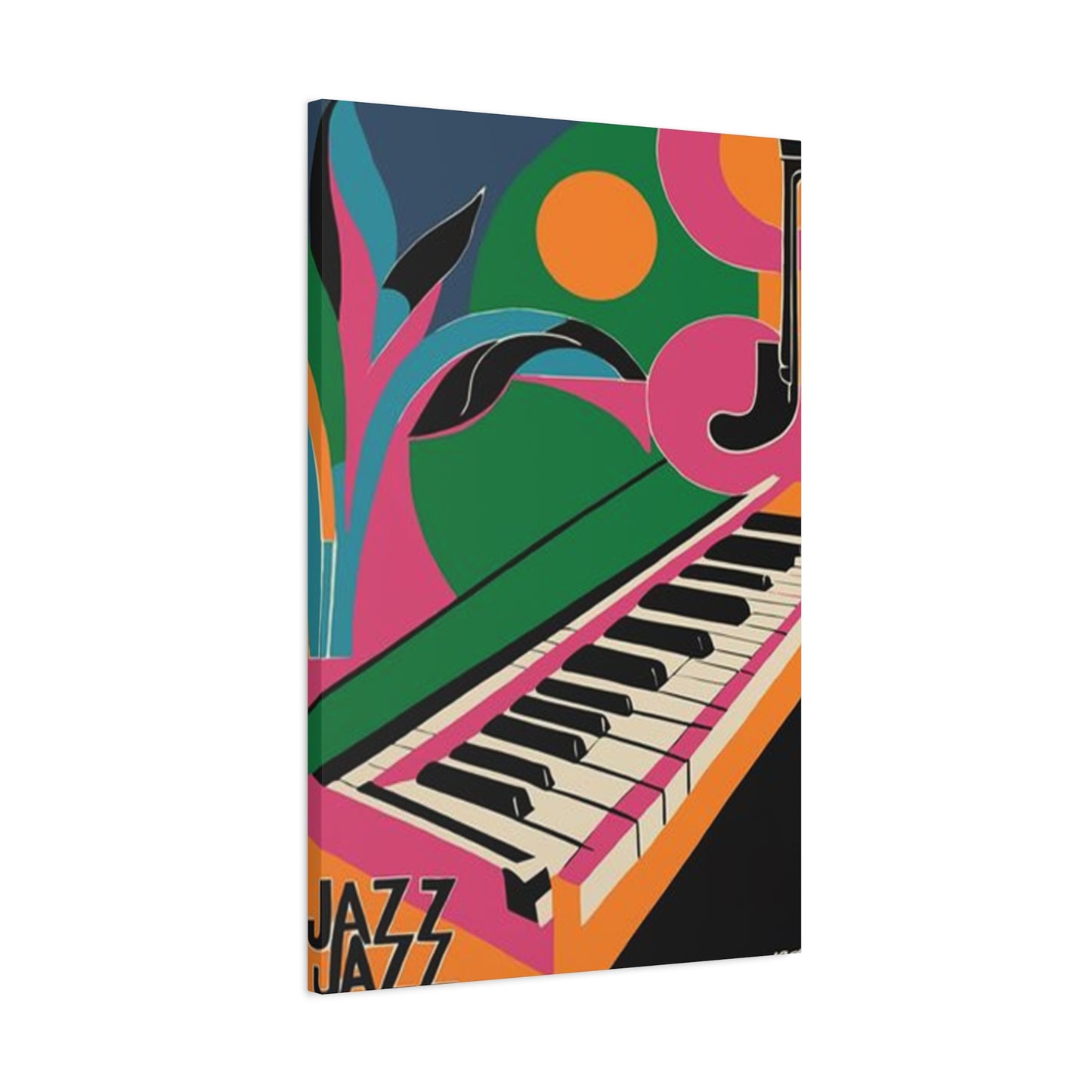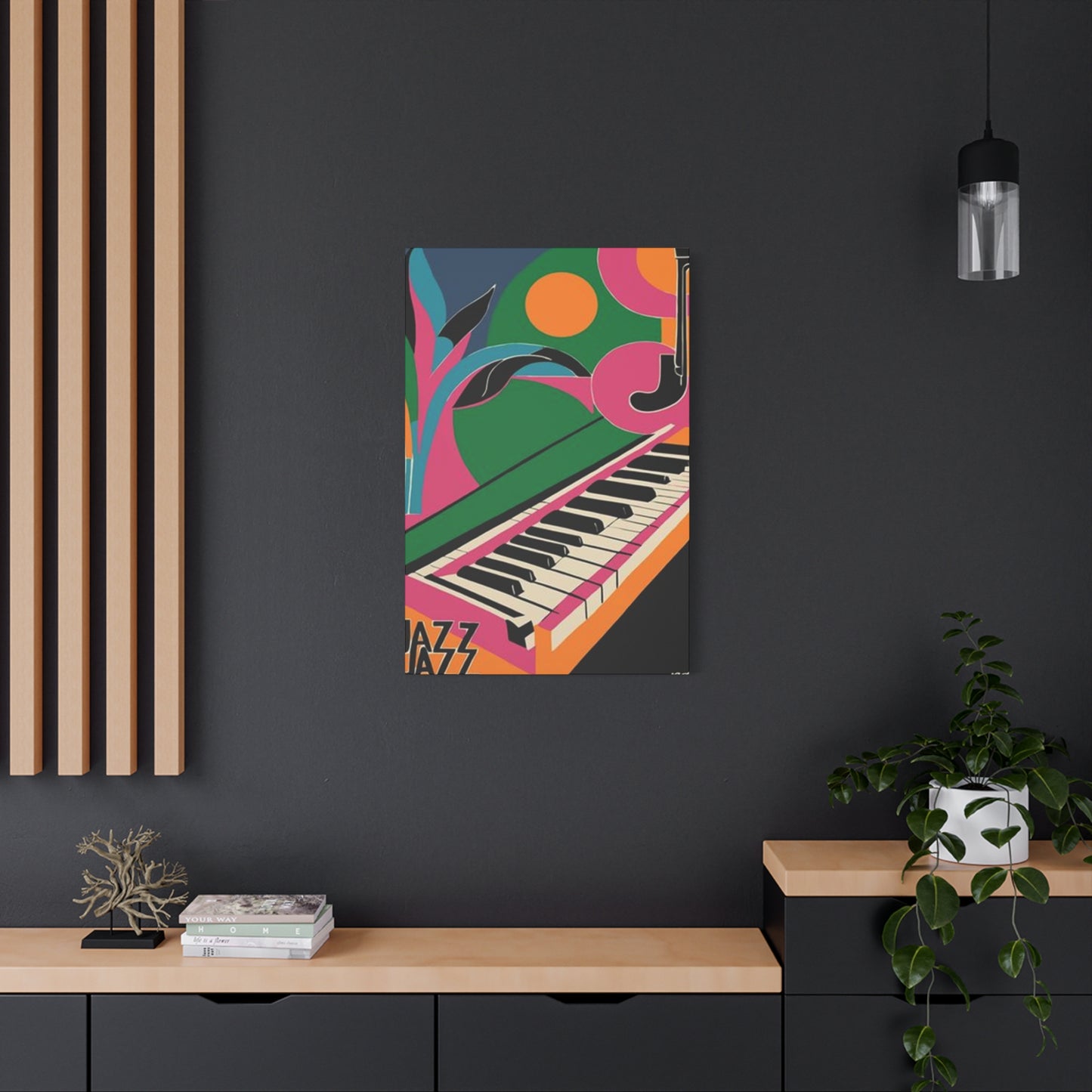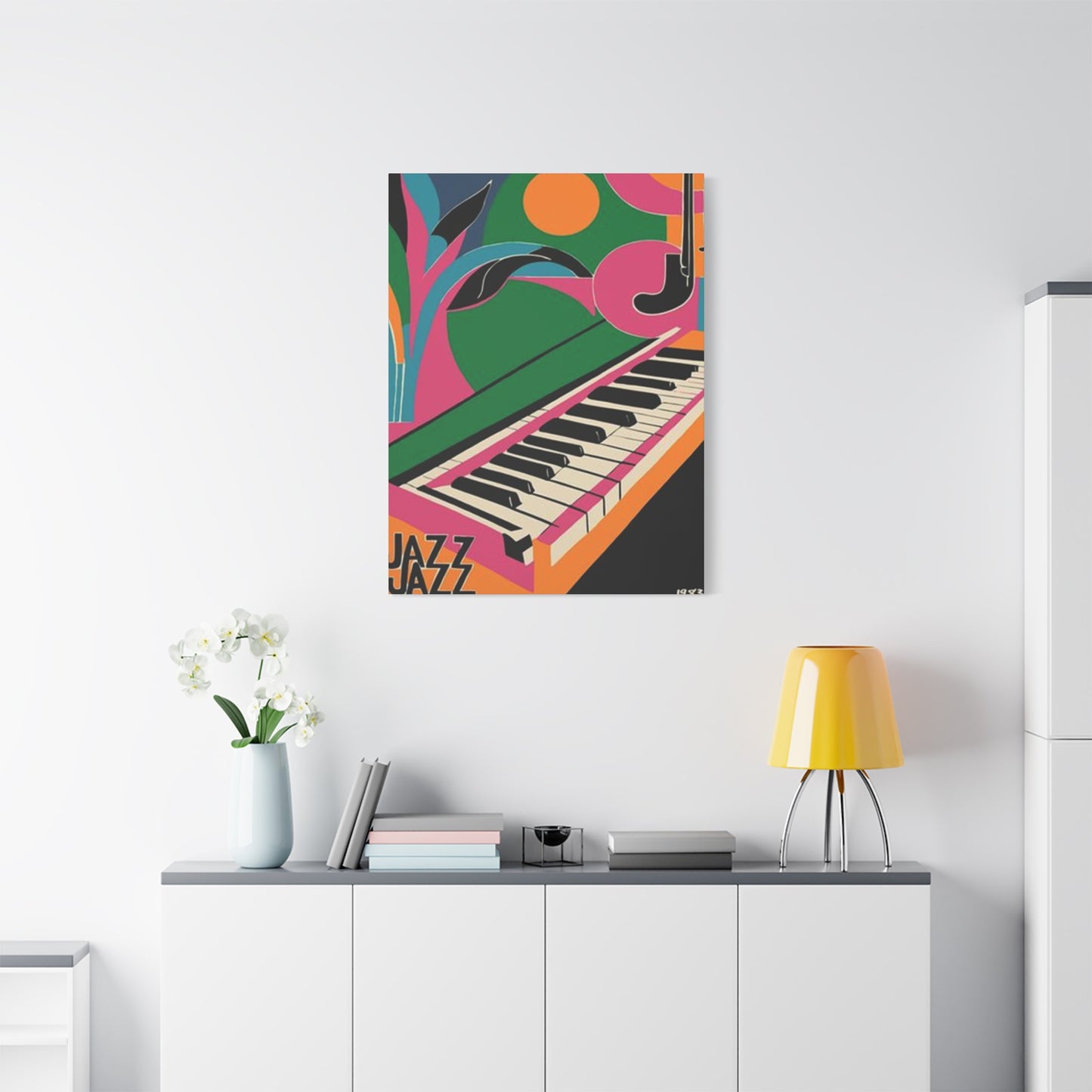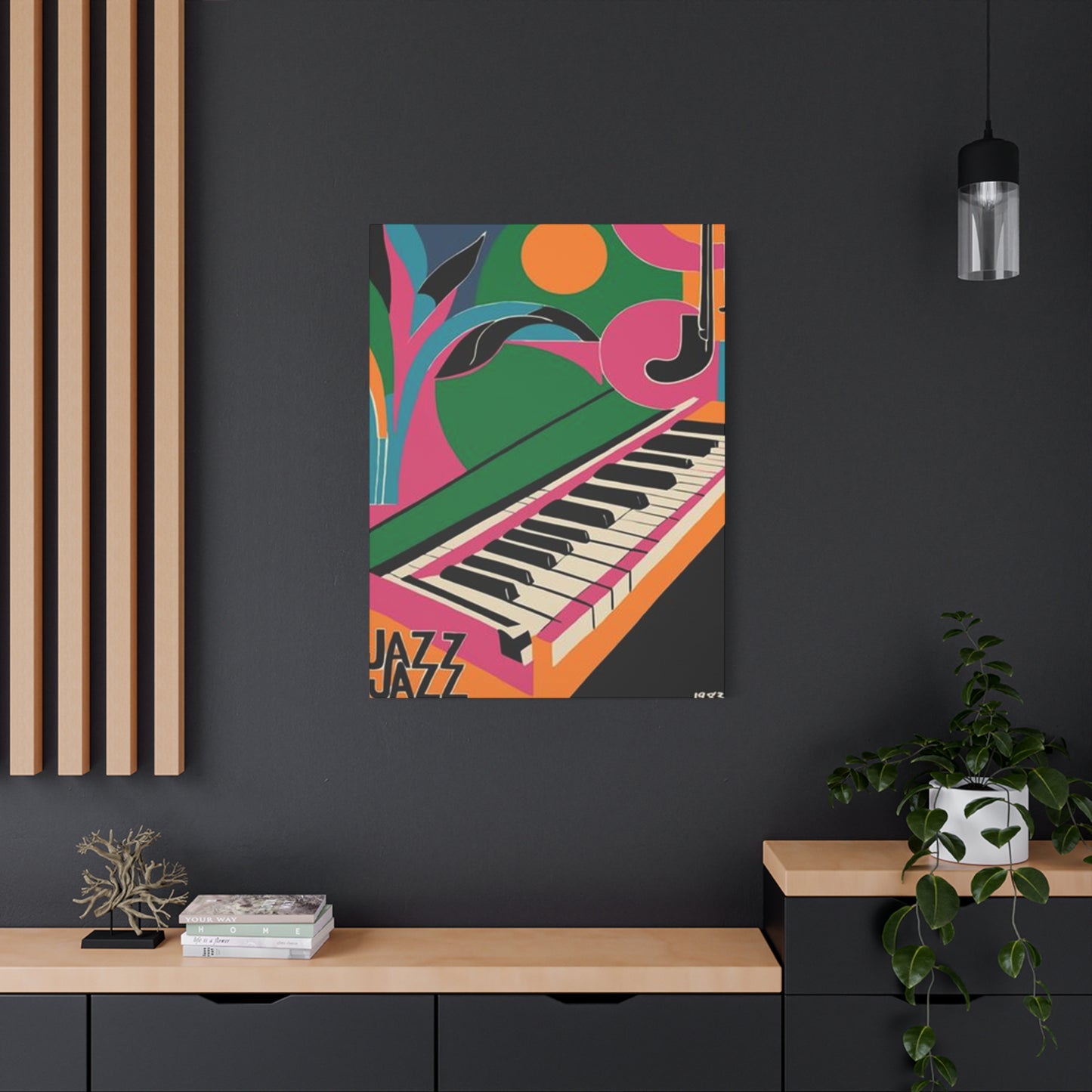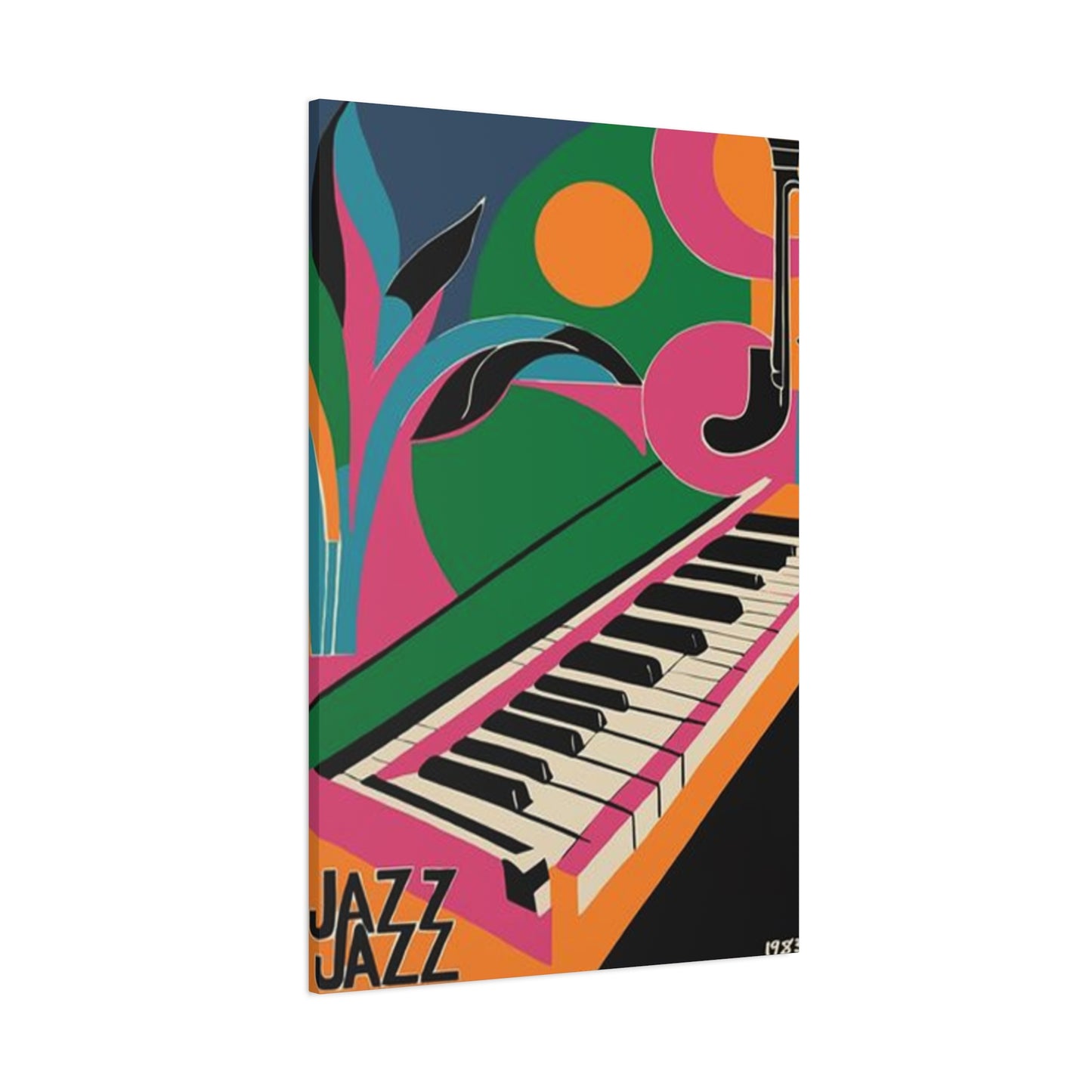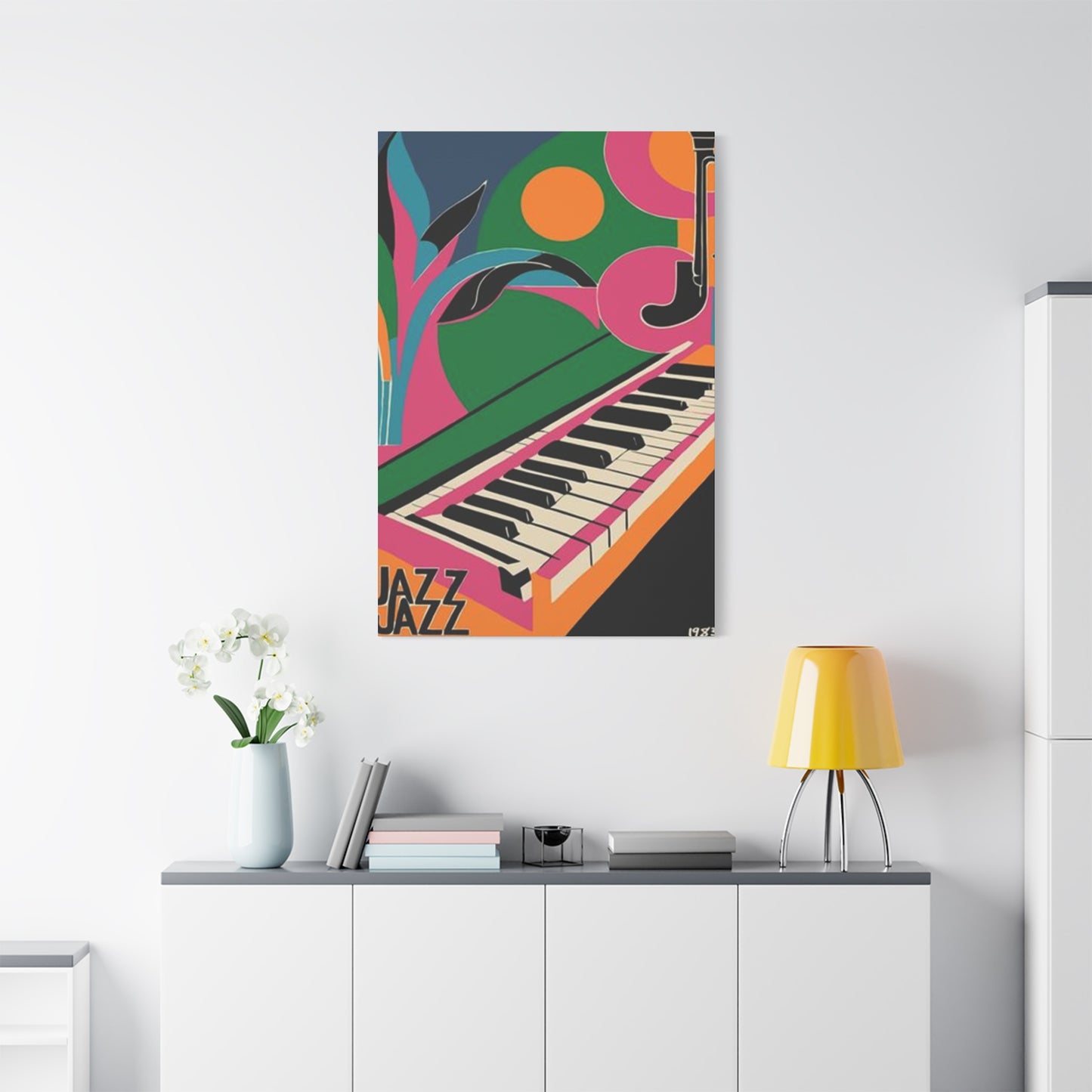Colorful Jazz Poster Wall Art & Canvas Prints
Colorful Jazz Poster Wall Art & Canvas Prints
Couldn't load pickup availability
Infuse Your Space with Soul and Style Through Colorful Jazz Poster Wall Art
The realm of jazz-inspired visual artistry represents a captivating intersection where musical heritage meets contemporary interior styling. Colorful jazz poster wall art has emerged as a powerful medium for transforming residential and commercial environments, offering homeowners, collectors, and design enthusiasts a distinctive approach to personalizing their surroundings while celebrating the rich cultural legacy of America's most influential musical genre.
These decorative pieces transcend conventional wall decorations, serving as conversation starters that reflect individual taste, cultural appreciation, and aesthetic sensibility. The dynamic nature of jazz itself—with its improvisation, rhythm, and emotional depth—translates remarkably well into visual form, creating artwork that captures the essence of spontaneity and creative expression that defines this musical tradition.
The Cultural Significance and Artistic Value of Jazz-Inspired Visual Expressions
Jazz music revolutionized American culture throughout the twentieth century, establishing itself as a cornerstone of artistic expression that influenced countless other creative disciplines. The visual representation of this musical form through posters and wall art creates a tangible connection to this transformative period in cultural history, allowing individuals to bring a piece of this legacy into their personal spaces.
The vibrant hues, bold typography, and dynamic compositions characteristic of jazz-themed artwork reflect the genre's inherent energy and spontaneity. Artists who create these pieces draw inspiration from legendary performers, iconic venues, and memorable performances that shaped musical history. Each composition tells a story, whether depicting a smoky club scene, an abstract interpretation of musical notes, or a stylized portrait of a renowned musician.
Collectors and enthusiasts recognize these pieces as more than mere decorations. They represent a celebration of creativity, freedom, and cultural resilience. The artwork serves as a visual reminder of the genre's roots in African American communities and its evolution into a globally recognized art form that transcends racial, cultural, and geographic boundaries.
Diverse Stylistic Approaches in Contemporary Jazz Wall Decorations
The market for colorful jazz poster wall art encompasses an extraordinary range of stylistic interpretations, each offering unique aesthetic qualities and emotional resonance. Vintage-inspired designs evoke nostalgia for the golden era of jazz clubs, featuring retro color palettes, distressed textures, and typography reminiscent of mid-century promotional materials.
Minimalist approaches strip away extraneous elements, focusing on essential forms and limited color schemes to create sophisticated, understated pieces that complement contemporary interior design philosophies. These works often employ geometric shapes, simplified silhouettes, and negative space to convey musical concepts through visual abstraction.
Abstract expressionist interpretations take a more experimental approach, using bold brushstrokes, splattered paint, and chaotic color combinations to mirror the improvisational nature of jazz performances. These pieces capture the raw emotion and spontaneous creativity that defines live musical expression, translating auditory experiences into visual form.
Photographic styles incorporate images of legendary performers, vintage instruments, and historic performance venues, often enhanced with digital manipulation, color filters, and graphic overlays to create hybrid works that blend documentary realism with artistic interpretation. These pieces appeal to those who value authenticity and historical connection in their decorative choices.
Pop art influences manifest in bright, saturated colors, bold outlines, and repetitive patterns that echo the work of artists like Andy Warhol and Roy Lichtenstein. This approach brings a playful, energetic quality to jazz-themed artwork, making it particularly suitable for modern, eclectic interior spaces.
Selecting the Perfect Piece for Your Unique Living Environment
Choosing the right colorful jazz poster wall art requires thoughtful consideration of multiple factors that extend beyond simple aesthetic preference. The physical dimensions of your space play a crucial role in determining appropriate artwork size. Larger walls in living rooms or dining areas can accommodate substantial pieces or multi-panel installations, while smaller spaces like hallways or powder rooms benefit from more compact compositions.
Color coordination represents another essential consideration. While jazz artwork typically features vibrant, bold hues, successful incorporation requires harmony with existing color schemes. You might choose pieces that complement your current palette, providing visual continuity, or select contrasting colors that create dramatic focal points and inject energy into neutral environments.
The overall design philosophy of your space should inform your selection process. Mid-century modern interiors naturally accommodate vintage-inspired jazz posters, while contemporary minimalist spaces might require more restrained, abstract interpretations. Eclectic environments offer greater flexibility, allowing you to mix various styles and periods without concern for strict aesthetic cohesion.
Personal connection matters immensely when selecting artwork. Consider which musicians, eras, or stylistic elements resonate most deeply with your own experiences and preferences. A piece that genuinely speaks to you will provide lasting satisfaction and become an integral part of your living environment rather than a fleeting trend.
Room function influences appropriate choices as well. Energetic, vibrant pieces work wonderfully in social spaces where they stimulate conversation and create atmosphere. More subdued, contemplative works might better suit private areas like bedrooms or home offices where tranquility takes precedence over stimulation.
Creating Stunning Visual Arrangements with Multiple Pieces
Gallery wall arrangements offer an exciting approach to displaying colorful jazz poster wall art, allowing you to create customized compositions that reflect your personal style while maximizing visual impact. This strategy works particularly well when you have collected multiple pieces that share thematic connections or complementary aesthetic qualities.
Symmetrical layouts provide formal, balanced arrangements that suit traditional or classic interior styles. This approach typically involves creating a grid pattern with evenly spaced pieces of similar dimensions, producing an orderly, harmonious visual effect that appeals to those who appreciate structure and predictability.
Asymmetrical compositions embrace a more organic, spontaneous aesthetic that mirrors jazz music's improvisational nature. This approach allows for greater creativity in combining pieces of varying sizes, orientations, and styles, resulting in dynamic arrangements that capture attention and invite extended viewing.
Salon-style hanging, inspired by traditional museum practices, involves covering substantial wall areas with densely packed artwork of various sizes and frames. This maximalist approach creates rich, layered visual experiences that work particularly well in bohemian, eclectic, or artist-inspired interiors where abundance and variety are celebrated rather than minimized.
Sequential arrangements tell visual stories by organizing pieces in deliberate progressions. You might create chronological displays that trace jazz history from its origins through various evolutionary periods, or thematic sequences that explore different aspects of the musical form—from New Orleans origins to bebop innovations to contemporary fusions.
Material Considerations and Production Quality in Jazz Artwork
The physical materials and production methods used in creating colorful jazz poster wall art significantly impact both aesthetic quality and longevity. Understanding these factors helps you make informed purchasing decisions that balance immediate visual appeal with long-term value and durability.
Paper quality represents the foundation of any poster or print. Archival-grade papers resist yellowing, fading, and deterioration, ensuring your artwork maintains its original appearance for decades. Acid-free materials prevent chemical degradation, while lignin-free compositions resist brittleness and discoloration over time.
Canvas prints offer texture and dimensionality that paper cannot match, creating gallery-like presentations that lend gravitas to jazz-themed artwork. Stretched canvas pieces arrive ready to hang without additional framing, offering convenient installation while presenting a professional, finished appearance.
Metal prints represent a contemporary alternative that produces striking visual effects, particularly with colorful, high-contrast compositions. The printing process infuses dyes directly into specially coated aluminum sheets, resulting in extraordinary color vibrancy, depth, and longevity. These pieces resist moisture, fading, and damage while offering a sleek, modern aesthetic.
Acrylic mounting creates depth and luminosity by sandwiching prints between clear acrylic sheets or mounting them directly to acrylic backing. Light penetrates the material, enhancing color saturation and creating an almost three-dimensional quality that makes artwork appear to glow from within.
Wood-mounted prints provide rustic charm and natural warmth, particularly appealing when paired with vintage-inspired jazz imagery. The wood grain adds texture and character, creating unique pieces where no two are exactly alike due to natural variations in the mounting material.
Framing Choices That Enhance Without Overwhelming
Appropriate framing elevates colorful jazz poster wall art from simple decoration to curated display worthy of gallery spaces. The frame serves multiple functions—protecting the artwork, providing structural support, and contributing aesthetic elements that complement or contrast with the piece itself.
Classic black frames offer timeless versatility that works across virtually all interior styles and color schemes. Their neutral quality allows the artwork to command attention without visual competition from the surrounding frame. Variations in black finish—from matte to glossy, from true black to charcoal—provide subtle distinctions that can be matched to specific decorative preferences.
Natural wood frames bring warmth and organic texture that particularly complement vintage-inspired jazz posters. Different wood species and finishes—from light maple to rich walnut—offer diverse aesthetic qualities. Distressed or weathered finishes enhance rustic, bohemian, or industrial interiors, while smooth, polished wood suits more refined, traditional spaces.
White frames create clean, contemporary presentations that work beautifully in minimalist and Scandinavian-inspired interiors. They provide crisp contrast against colored walls while maintaining visual lightness that prevents heavy, oppressive feelings in smaller spaces.
Metallic frames in gold, silver, bronze, or copper introduce glamorous, sophisticated elements that elevate artwork presentation. Gold tones pair exceptionally well with warm color palettes and vintage aesthetics, while silver complements cool tones and contemporary designs.
Ornate, decorative frames suit traditional or maximalist interiors where embellishment is embraced rather than avoided. Baroque-style frames with intricate carvings and gilded finishes can create dramatic, museum-like presentations that transform artwork into focal points commanding immediate attention.
Strategic Placement Strategies for Maximum Visual Impact
The location and positioning of your colorful jazz poster wall art dramatically affects its visual impact and the overall atmosphere of your space. Strategic placement considers viewing angles, lighting conditions, spatial relationships, and the psychological effects of artwork positioning.
Eye-level hanging represents the standard approach, positioning artwork center points approximately 57 to 60 inches from the floor—the average human eye height. This placement ensures comfortable viewing without strain, though it should be adjusted when furniture arrangements create different primary viewing positions.
Above furniture placements require careful consideration of proportions and spacing. When hanging artwork above sofas, headboards, or console tables, leave approximately 6 to 12 inches of space between furniture tops and artwork bottoms. The artwork width should span roughly two-thirds to three-quarters of the furniture width to maintain balanced proportions.
Corner placements offer opportunities to activate underutilized spaces while creating unexpected visual interest. Jazz artwork in corners can anchor seating arrangements, define conversation areas, or serve as transitional elements between adjacent spaces with different functional purposes.
Architectural features like fireplaces, alcoves, or built-in shelving provide natural frameworks for artwork display. These locations often function as existing focal points, making them ideal for showcasing particularly striking or valuable pieces that deserve prominence in your decorative scheme.
Unexpected locations create delightful surprises that elevate everyday experiences. Consider placing jazz-themed artwork in powder rooms, walk-in closets, laundry rooms, or other utilitarian spaces where decorative attention is often neglected. These placements transform mundane areas into memorable experiences.
Lighting Considerations That Showcase Artwork Properly
Proper illumination dramatically enhances the appearance and impact of colorful jazz poster wall art while protecting pieces from light-related damage. Understanding lighting principles helps you create displays that showcase your artwork beautifully without compromising its longevity.
Natural light offers wonderful illumination that reveals colors and details with exceptional clarity, but it also poses significant risks. Ultraviolet radiation causes fading, discoloration, and material degradation over time. If displaying artwork in naturally lit areas, position pieces away from direct sunlight, use UV-filtering window treatments, or apply protective glazing to frame glass.
Picture lights—small fixtures mounted directly above or below artwork—provide focused illumination that highlights specific pieces while creating dramatic effects. These fixtures come in various styles from traditional brass to sleek contemporary designs, allowing you to match aesthetic preferences while providing dedicated lighting.
Track lighting offers flexible solutions that can be adjusted to illuminate multiple pieces or reconfigured as your display evolves. This approach works particularly well for gallery walls or situations where artwork arrangements change periodically. Select fixtures with adjustable heads to direct light precisely where needed.
Recessed ceiling lights create clean, unobtrusive illumination without visible hardware. When properly positioned and aimed, these fixtures wash walls with even light that showcases artwork without harsh shadows or glare. Dimmer controls allow you to adjust intensity based on time of day or desired atmosphere.
Ambient room lighting affects how artwork appears even when not directly illuminated. Warm-toned light bulbs enhance reds, oranges, and yellows while potentially dulling blues and greens. Cool-toned bulbs have opposite effects. Consider your artwork's predominant colors when selecting bulb color temperatures for surrounding fixtures.
Preserving and Protecting Your Valuable Art Pieces
Maintaining colorful jazz poster wall art in pristine condition requires understanding environmental factors that affect artwork longevity and implementing appropriate protective measures. Proper care ensures your pieces remain vibrant and structurally sound for years or even generations.
Humidity control proves essential for paper-based artwork, as excessive moisture promotes mold growth, paper warping, and adhesive failure. Conversely, extremely dry conditions cause brittleness and cracking. Maintain relative humidity between 40-60% for optimal preservation, using humidifiers or dehumidifiers as needed to achieve stable conditions.
Temperature stability matters nearly as much as humidity levels. Dramatic temperature fluctuations cause expansion and contraction that stresses materials, potentially leading to warping, cracking, or separation between layers. Avoid hanging artwork near heating vents, radiators, fireplaces, or exterior walls that experience significant temperature variations.
Dust accumulation diminishes visual appeal while potentially causing abrasion damage during cleaning attempts. Regular dusting with soft, dry microfiber cloths prevents buildup without introducing moisture or chemicals that might damage materials. For framed pieces, clean both the glass surface and frame surfaces gently.
Protective glazing—whether glass or acrylic—shields artwork from airborne pollutants, accidental contact, and moisture while offering varying degrees of UV protection. Museum-quality glazing blocks up to 99% of harmful ultraviolet light, significantly extending artwork lifespan at premium cost. Standard conservation glazing offers moderate protection at more accessible price points.
Periodic inspection identifies emerging issues before they become serious problems. Check for signs of fading, discoloration, pest damage, mold growth, or structural problems like warping or frame separation. Early detection allows for interventions that prevent minor issues from escalating into major damage requiring costly restoration.
The Investment Value of Quality Jazz-Themed Artwork
Colorful jazz poster wall art represents both aesthetic enhancement and potential financial investment, particularly when selecting limited editions, pieces by recognized artists, or vintage originals from significant periods in jazz history. Understanding factors that influence value helps you make informed acquisition decisions.
Limited edition prints carry greater value than unlimited reproductions due to their controlled availability. Artists or publishers produce predetermined numbers of prints, often numbering and signing each piece. Lower edition numbers and smaller total editions generally command higher prices and appreciate more reliably over time.
Artist reputation significantly impacts value trajectories. Works by established artists with recognized names, exhibition histories, and critical acclaim typically hold value better and appreciate more reliably than pieces by unknown creators. Research artists whose work you're considering, examining their credentials, exhibition records, and market presence.
Provenance documentation—the recorded history of ownership and authenticity—substantially affects artwork value, particularly for vintage pieces or limited editions. Certificates of authenticity, gallery receipts, exhibition records, and previous ownership documentation all contribute to establishing legitimacy and supporting valuation claims.
Condition directly correlates with value across all artwork categories. Pieces in excellent condition with minimal wear, no damage, and original materials intact command premium prices compared to damaged or restored examples. Proper storage, display, and handling preserve condition, protecting your investment.
Market trends influence values across collecting categories, including jazz-themed artwork. Growing interest in specific artists, periods, or styles can drive rapid appreciation, while declining interest may stagnate or reduce values. Collecting based on personal enjoyment rather than purely speculative motives provides satisfaction regardless of market fluctuations.
Sourcing Authentic and High-Quality Jazz Artwork
Acquiring colorful jazz poster wall art from reputable sources ensures authenticity, quality, and value while supporting artists and legitimate distributors. Understanding various acquisition channels helps you navigate the marketplace successfully and avoid problematic purchases.
Online marketplaces provide vast selection and convenient shopping, though they require vigilance regarding seller reputation, return policies, and authenticity verification. Established platforms with buyer protection programs, verified seller credentials, and transparent customer reviews offer more security than informal venues lacking these safeguards.
Specialized art dealers focusing on music-related artwork bring expertise and curated selections that simplify discovery while ensuring quality and authenticity. These professionals often establish relationships with artists, maintain limited edition inventories, and provide authentication services that protect buyers from fraudulent pieces.
Direct artist purchases support creators most effectively while often providing access to unique pieces, commission opportunities, and personalized service. Many artists maintain websites, studios, or participate in art fairs where they sell work directly without intermediary markups. This approach often allows for customization requests or exclusive pieces.
Auction houses handle significant artwork transactions, including vintage jazz posters and limited edition prints. While potentially offering access to rare pieces, auctions require understanding bidding processes, buyer premiums, and authentication practices. Reputable auction houses provide condition reports and provenance documentation for lots.
Gallery exhibitions showcase curated collections in physical spaces where you can examine pieces closely before purchasing. Galleries often represent specific artists or stylistic movements, providing focused selections rather than overwhelming variety. Staff expertise helps guide selections based on your preferences and requirements.
Estate sales and antique markets occasionally yield vintage jazz posters and artwork at favorable prices, though these venues require knowledge to distinguish valuable pieces from reproductions or damaged goods. Careful examination and research help identify worthwhile acquisitions while avoiding problematic purchases.
Contemporary Artists Reimagining Jazz Visual Traditions
Modern creators continue evolving the visual language of jazz artwork, bringing fresh perspectives while honoring historical traditions. These artists employ contemporary techniques, materials, and aesthetic sensibilities to create colorful jazz poster wall art that resonates with current audiences while maintaining connections to musical heritage.
Digital artists leverage software capabilities to create compositions impossible through traditional media, employing layering, filtering, and manipulation that produce striking visual effects. These creators often blend photographic elements with illustrated components, typography, and abstract shapes to build complex, multi-dimensional pieces.
Street art influences manifest in bold graphics, spray paint aesthetics, and urban cultural references that connect jazz's historical roots in African American urban communities with contemporary hip-hop and graffiti cultures. This approach creates visually arresting pieces that appeal to younger audiences while maintaining authentic cultural connections.
Mixed media approaches combine diverse materials and techniques—painting, collage, printmaking, photography—creating textured, layered works that transcend single-medium limitations. These pieces often incorporate three-dimensional elements like fabric, metal, or found objects that add physicality and depth beyond flat surface decoration.
Conceptual artists use jazz themes to explore broader ideas about improvisation, collaboration, cultural identity, and creative expression. These works may employ unconventional formats, materials, or presentation methods that challenge traditional notions of decorative artwork while stimulating intellectual engagement alongside aesthetic appreciation.
Emerging artists bring diverse cultural perspectives that expand jazz imagery beyond its American origins, incorporating visual traditions from African, Caribbean, Latin American, and European cultures that influenced jazz music's evolution. These cross-cultural interpretations enrich the visual vocabulary available to collectors and enthusiasts.
Creating Cohesive Thematic Displays Throughout Your Home
Developing consistent visual themes using colorful jazz poster wall art creates harmonious environments where individual pieces combine into greater aesthetic wholes. Thoughtful curation produces cohesive displays that tell stories, establish atmospheres, and reflect personal identity more effectively than random assemblages.
Color palette consistency provides the simplest approach to thematic unity. Selecting pieces that share predominant hues—perhaps blues and golds, or reds and blacks—creates visual continuity even when compositions, subjects, or styles vary significantly. This approach works across rooms or within single spaces.
Era-specific themes focus on particular periods in jazz history—New Orleans origins, swing era, bebop revolution, cool jazz, fusion experiments, or contemporary expressions. This chronological approach appeals to those passionate about specific musical periods while providing educational context for viewers unfamiliar with jazz history.
Geographic themes explore jazz's relationship with specific cities or regions—New Orleans, Chicago, Kansas City, New York, or international scenes in Paris, London, or Tokyo. These location-based collections celebrate jazz's global reach while potentially incorporating local visual traditions and architectural motifs.
Instrument-focused displays organize artwork around specific instruments—trumpets, saxophones, pianos, bass, drums—creating specialized collections that appeal to musicians or those particularly drawn to certain instrumental sounds. These themes allow for diverse stylistic interpretations while maintaining clear conceptual focus.
Mood-based curation selects pieces based on emotional qualities rather than literal subjects. A relaxed, contemplative theme might feature cool color palettes, spacious compositions, and solo performers, while energetic themes emphasize warm colors, dense compositions, and ensemble performances.
The Psychological Benefits of Music-Inspired Visual Art
Surrounding yourself with colorful jazz poster wall art provides more than aesthetic pleasure, offering genuine wellness benefits through environmental enrichment. Research demonstrates that thoughtfully decorated spaces positively influence mood, cognitive function, and overall quality of life.
Emotional regulation improves in environments featuring artwork that resonates personally. Jazz-themed pieces may evoke specific memories, cultural connections, or aesthetic preferences that generate positive emotional responses when encountered throughout daily routines. These small moments of pleasure accumulate into meaningful quality-of-life improvements.
Cognitive stimulation occurs when artwork provides visual interest that engages attention without overwhelming senses. Complex compositions reward repeated viewing as new details emerge over time, while simpler pieces offer restful focal points. Both approaches contribute to environmental richness that supports mental engagement.
Identity expression through decorative choices contributes to psychological wellbeing by creating spaces that authentically reflect personal values, interests, and aesthetic sensibilities. Living in environments that feel genuinely "yours" rather than generic or conforming to others' expectations supports self-esteem and contentment.
Social connection opportunities arise when distinctive artwork sparks conversations, shared memories, or common interests between hosts and guests. Jazz posters often initiate discussions about musical preferences, concert experiences, or cultural history that deepen interpersonal bonds and create memorable interactions.
Stress reduction results from creating calm, aesthetically pleasing environments where you feel comfortable and relaxed. While individual preferences vary, most people experience reduced stress in spaces they find visually appealing compared to cluttered, chaotic, or unappealing environments.
Pairing Jazz Artwork with Complementary Decor Elements
Maximizing the impact of colorful jazz poster wall art requires coordination with surrounding decor elements that enhance rather than compete with your artwork. Strategic choices regarding furniture, textiles, accessories, and overall styling create unified spaces where all components work harmoniously.
Furniture selection influences how artwork is perceived and experienced. Clean-lined, minimalist pieces provide neutral backdrops that allow artwork to command attention, while ornate, decorative furniture creates layered, maximalist environments where artwork integrates into broader visual complexity. Match furniture aesthetic to artwork style for cohesion or deliberately contrast them for eclectic energy.
Textile choices in upholstery, window treatments, and rugs can either complement or deliberately contrast artwork colors. Pulling accent colors from artwork into textiles creates visual continuity and harmonious flow. Alternatively, neutral textiles allow colorful artwork to provide primary visual interest without competing patterns or hues.
Decorative accessories—sculptures, vases, candlesticks, books—offer opportunities to reinforce themes established by artwork. Jazz-themed accessories like vintage instruments, musician photographs, or music-related books create dedicated spaces celebrating musical culture. Alternatively, minimal accessories maintain focus on artwork as primary decorative element.
Architectural elements including molding, wainscoting, or accent walls interact with artwork presentation. Neutral walls in white, gray, or beige provide traditional backdrops that showcase artwork effectively, while bold accent colors create dramatic settings that either complement or contrast with artwork hues.
Lighting fixtures contribute aesthetic qualities beyond their functional purposes. Industrial-style fixtures complement urban, edgy jazz imagery, while mid-century modern lighting pairs naturally with vintage posters. Contemporary minimalist fixtures suit abstract or modern jazz interpretations.
Seasonal Rotation Strategies for Fresh Perspectives
Periodically changing your displayed colorful jazz poster wall art prevents visual stagnation while allowing you to enjoy larger collections without overwhelming spaces. Rotation strategies keep environments feeling fresh and dynamic while protecting stored pieces from prolonged light exposure.
Quarterly rotations align with seasonal changes, allowing you to adjust artwork to complement shifting moods, activities, and even color preferences associated with different times of year. Warmer, more energetic pieces might suit spring and summer, while introspective, cooler compositions align with fall and winter atmospheres.
Thematic rotations respond to personal interests, current events, or household activities. During periods when you're exploring specific jazz styles, eras, or musicians, display related artwork to deepen your engagement. Rotate pieces when interests shift to maintain alignment between your spaces and current passions.
Proper storage protects artwork during rotation periods. Store pieces in cool, dry locations away from direct light, extreme temperatures, and humidity fluctuations. Use acid-free tissue paper between stacked prints, store rolled canvases in archival tubes, and keep framed pieces upright rather than stacked to prevent pressure damage.
Documentation systems help track your collection, noting which pieces are displayed, stored, or loaned. Simple spreadsheets or inventory apps record locations, dimensions, artists, acquisition dates, and condition notes. This organization simplifies rotation planning while providing records for insurance purposes.
Rotation events transform artwork changes into enjoyable activities rather than tedious chores. Involve household members in selection processes, take photographs of arrangements before disassembling them, and treat installations as opportunities to refresh spaces and reconsider existing decorative choices.
Commissioning Custom Jazz-Themed Artwork
Working directly with artists to create custom colorful jazz poster wall art ensures unique pieces perfectly suited to your spaces, preferences, and requirements. While more involved than purchasing existing work, commissioning offers unparalleled personalization and the satisfaction of collaborating in creative processes.
Artist selection represents the critical first step. Research creators whose existing work aligns with your aesthetic preferences, then review portfolios to assess stylistic range, technical proficiency, and thematic interests. Many artists welcome commissions even when their portfolios don't show exactly what you envision.
Communication clarity prevents misunderstandings and ensures satisfactory results. Provide detailed descriptions of desired subjects, styles, color preferences, and dimensions. Share reference images that illustrate aesthetic qualities you're seeking, even when those references aren't jazz-related. Specify intended display locations and surrounding decor to help artists create appropriate pieces.
Budget discussions should occur early in conversations. Custom artwork pricing varies enormously based on artist reputation, piece size, medium, complexity, and timeline. Be transparent about your budget constraints while remaining open to artists' pricing structures, which reflect their experience, costs, and time investment.
Timeline expectations require realistic assessment. Quality artwork creation demands time for conceptualization, sketching, revision, execution, and finishing. Rush timelines typically incur premium charges when artists can accommodate them. Plan commissions well in advance of desired completion dates.
Revision provisions should be established before work begins. Most artists include limited revision rounds in commission agreements, allowing you to request adjustments before final completion. Understand what constitutes revisions versus fundamental changes that might incur additional charges.
Contracts protect both parties by documenting agreements regarding specifications, pricing, payment schedules, timelines, revision allowances, intellectual property rights, and cancellation terms. Written agreements prevent disputes and ensure mutual understanding of expectations and responsibilities.
Vintage Jazz Poster Collecting as Serious Pursuit
Original vintage jazz posters from mid-twentieth century represent specialized collecting categories attracting serious enthusiasts who value historical authenticity, rarity, and cultural significance. These pieces offer tangible connections to specific performances, venues, and cultural moments that shaped musical history.
Authentication challenges require expertise or professional verification services. Numerous reproductions, reprints, and outright forgeries complicate vintage poster markets. Authenticators examine paper composition, printing methods, inks, aging patterns, and provenance documentation to distinguish genuine vintage pieces from later productions.
Rarity factors dramatically influence values within vintage categories. Posters promoting specific legendary performances—particularly those featuring multiple renowned musicians or commemorating significant cultural moments—command premium prices when authentic examples emerge. Conversely, mass-produced promotional materials from common events offer accessibility for collectors with modest budgets.
Condition grading follows standardized systems that assess physical state from mint to poor conditions. Mint examples show no defects, wear, or damage. Near-mint pieces display minimal wear from careful handling. Very good condition allows moderate wear but no significant damage. Good, fair, and poor grades reflect increasing levels of damage, repairs, or deterioration.
Restoration considerations present ethical questions within collecting communities. Some purists insist on preserving pieces in original condition despite damage, while pragmatists accept professional restoration that preserves visual appeal while disclosing interventions. Restoration affects values unpredictably—sometimes enhancing marketability, sometimes reducing worth among purist collectors.
Specialized knowledge development separates casual buyers from serious collectors. Understanding printing techniques, paper types, typography evolution, historical contexts, and market trends enables informed decisions. Many collectors join specialty organizations, attend conferences, and build relationships with dealers who provide expertise alongside inventory access.
Educational Value and Cultural Preservation Through Art
Colorful jazz poster wall art serves purposes beyond decoration, functioning as visual educational resources that introduce viewers to musical history, cultural movements, and artistic evolution. These pieces preserve and communicate cultural heritage while stimulating curiosity and learning.
Historical documentation value increases as original materials age. Vintage posters provide primary source evidence of performance dates, venues, pricing, and promotional practices from specific periods. Scholars studying cultural history, entertainment industries, or visual communication find authentic materials invaluable for research purposes.
Visual literacy development occurs through engagement with diverse artistic styles, compositions, and symbolic languages. Analyzing how artists communicate concepts visually—whether through color choices, compositional decisions, typography, or symbolic imagery—builds critical thinking skills applicable across numerous contexts.
Cultural awareness expansion happens naturally when artwork introduces viewers to musical traditions, historical periods, or cultural communities unfamiliar to them. Jazz-themed artwork can spark interest leading to deeper exploration of African American cultural history, musical evolution, or specific artists and their contributions.
Intergenerational connection opportunities arise when artwork bridges age gaps through shared cultural references. Older generations who experienced jazz's golden eras firsthand can share memories and knowledge with younger people encountering this material through contemporary artwork, fostering understanding and relationship building.
Preservation responsibility falls partially on collectors who protect cultural artifacts from loss, damage, or destruction. By valuing, maintaining, and occasionally sharing these materials, collectors contribute to broader cultural preservation efforts that ensure future generations can access and learn from historical resources.
Global Jazz Traditions Reflected in Visual Art
While jazz originated in American cultural contexts, its global spread produced diverse regional expressions that influenced visual representations. Colorful jazz poster wall art increasingly reflects these international perspectives, enriching available imagery beyond American-centric narratives.
European jazz scenes, particularly in France, Netherlands, and Scandinavia, developed distinctive visual styles influenced by local artistic traditions. French jazz posters often employed sophisticated graphic design reflecting broader Parisian artistic movements, while Nordic countries brought minimalist sensibilities to jazz imagery.
Latin American influences appear in artwork celebrating Afro-Cuban jazz, Brazilian bossa nova, and other regional fusions where jazz intersected with indigenous musical traditions. These pieces often incorporate vibrant colors, tropical imagery, and rhythmic visual patterns reflecting the musical traditions they represent.
African perspectives provide particularly meaningful contributions given jazz's roots in African musical traditions and African diaspora experiences. Contemporary African artists creating jazz-themed work bring cultural viewpoints that reconnect the music with ancestral traditions while addressing contemporary African experiences.
Asian jazz communities in Japan, South Korea, and elsewhere have produced distinctive visual interpretations influenced by local artistic traditions, calligraphy, and aesthetic philosophies. Japanese jazz posters, for instance, sometimes blend traditional woodblock print aesthetics with contemporary graphic design.
Cross-cultural fusion artwork explicitly celebrates jazz's role as cultural bridge, combining visual elements from diverse traditions into unified compositions. These pieces embody the collaborative, syncretic nature of jazz itself, demonstrating how cultural exchange produces new forms transcending individual traditions.
Conclusion
Different rooms serve distinct functions and create varying contexts for colorful jazz poster wall art. Understanding room-specific considerations helps you select and place artwork appropriately for maximum enjoyment and effectiveness.
Living room placements benefit from substantial, visually striking pieces that function as focal points while withstanding scrutiny from multiple viewing angles. These social spaces accommodate both energetic artwork that stimulates conversation and sophisticated pieces that demonstrate taste and cultural awareness.
Bedroom selections might emphasize calmer, more contemplative compositions that promote relaxation rather than stimulation. Cool color palettes, spacious compositions, and individual performers often work better than chaotic, high-energy pieces that might hinder rest and relaxation.
Home office environments appreciate artwork that inspires creativity, provides mental breaks, and reflects professional identity. Jazz themes communicate sophistication, creativity, and cultural awareness—qualities valuable in professional contexts. Choose pieces that reward brief viewing breaks without becoming distracting.
Dining room artwork should complement the social, celebratory nature of shared meals. Energetic pieces featuring ensemble performances or crowded club scenes reinforce communal dining experiences. Consider how artwork appears under various lighting conditions including candlelight for evening meals.Kitchen spaces, often overlooked for serious artwork, benefit from jazz-themed pieces that acknowledge music's relationship with food, celebration, and community gathering. Select moisture-resistant materials or protective framing given potential exposure to cooking humidity and temperature fluctuations.
Bathroom placements require careful material selection to withstand humidity while creating spa-like atmospheres or adding unexpected personality to utilitarian spaces. Jazz artwork in powder rooms impresses guests with attention to detail and willingness to extend decorative care throughout the entire home.
Music rooms, studios, or listening spaces naturally accommodate jazz artwork that reinforces the room's purpose while celebrating musical traditions. These dedicated spaces allow for more extensive collections or thematic displays that might overwhelm multipurpose areas.
Building impressive displays of colorful jazz poster wall art doesn't require unlimited resources. Strategic approaches allow budget-conscious collectors to create meaningful, attractive displays while developing collections that grow and evolve over time.
Print-on-demand services provide access to thousands of designs at accessible prices by producing individual items as ordered rather than maintaining inventory. While quality varies between providers, many offer archival materials and professional finishing at fractions of traditional gallery prices.
Digital downloads allow you to purchase high-resolution files for self-printing, offering maximum flexibility in sizing and format selection. Local print shops or online services print files to your specifications, often at lower costs than purchasing pre-printed pieces, though you assume responsibility for material selection and quality assurance.Emerging artist support provides multiple benefits—acquiring original or limited edition pieces at accessible prices while supporting creators early in their careers. As artists gain recognition, early acquisitions may appreciate substantially while providing satisfaction of having supported talent before widespread discovery.
Secondary markets including consignment shops, thrift stores, estate sales, and online resale platforms occasionally yield significant finds at bargain prices. Successful treasure hunting requires patience, regular searching, and knowledge to recognize valuable pieces among less desirable offerings.
DIY framing dramatically reduces costs compared to professional custom framing. Pre-made frames from home goods stores, online retailers, or thrift sources provide functional presentation at minimal expense. Basic framing skills develop quickly through online instruction, allowing you to frame entire collections for costs similar to professionally framing individual pieces.
Sales, promotions, and discount codes reduce acquisition costs when timed strategically. Sign up for newsletters from retailers and artists whose work interests you, enabling you to capitalize on periodic discounts, clearance events, or special promotions.Successfully incorporating colorful jazz poster wall art requires balancing personal preferences with established design principles that create harmonious, functional spaces. This balance ensures rooms feel both personally meaningful and aesthetically successful.
Scale proportions matter significantly in artwork selection and placement. Oversized pieces overwhelm small spaces while tiny artwork gets lost on expansive walls. Generally, artwork should occupy roughly two-thirds to three-quarters of available wall width in featured locations, adjusted based on ceiling heights and surrounding elements.
Visual weight distribution affects perceived balance within rooms. Heavy, dark, or densely detailed artwork carries more visual weight than light, spacious, or minimal pieces.
Share

